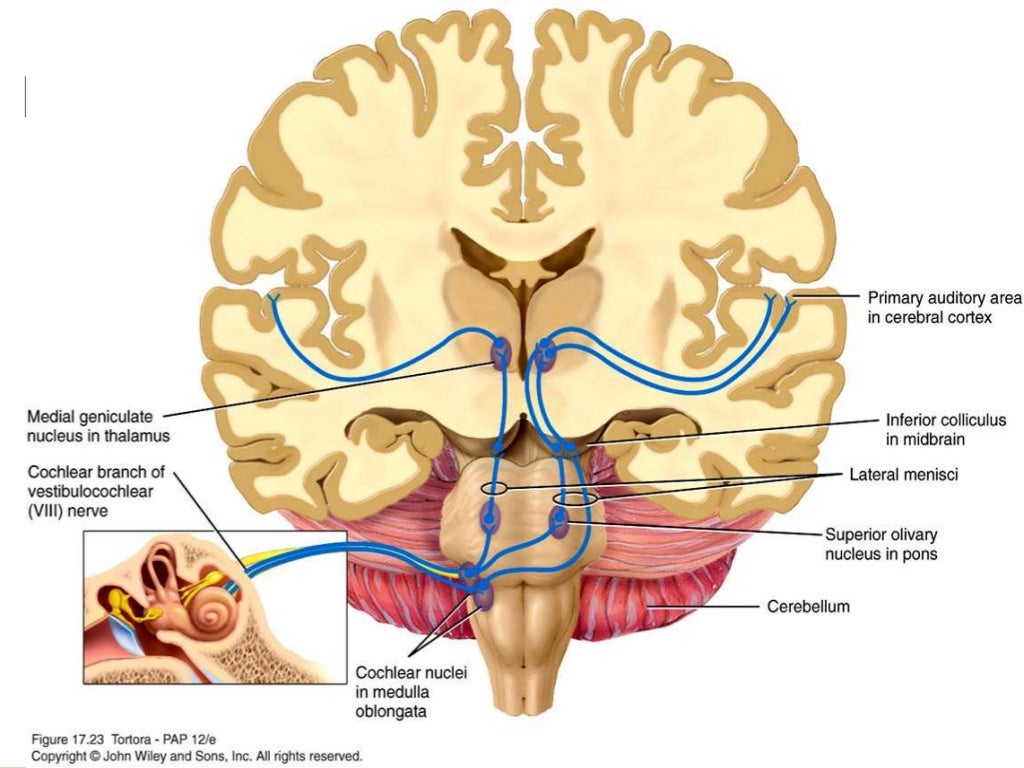
This vibration of the tympanic membrane is translated to movement and vibration of three ossicles present in the middle ear, the malleus, incus, and stapes, to further transmit vibrations to the oval window of the inner ear. As sound waves travel through the air and are collected by the pinna of the ear, they are transmitted down the external auditory canal where they will produce vibrations of the tympanic membrane. The path sound takes from the external environment to the primary auditory area and associated auditory areas, is complicated by many synapses, decussations, and inputs to brainstem nuclei bilaterally and both cerebral hemispheres. Pathway of Sound from Peripheral to Central Auditory Structures: The left Heschl gyrus in the majority of individuals is significantly longer when compared to the right gyrus, suggesting a correlation between left-hemisphere language dominance and associated differences in anatomical structure. It runs towards the center of the brain in a medial-posterior fashion. Heschl gyrus cannot be visualized from a lateral view of the cerebral cortex since it is located deep to the superficial temporal lobe structure and is within the lateral sulcus. This cortex, along with associated auditory areas, is clustered surrounding the posterior aspect of the Sylvian fissure or lateral sulcus of the cerebral cortex, which separates the temporal lobe inferiorly from the parietal and frontal lobe superiorly. The primary auditory area is housed within Heschl gyrus, a region that is positioned posteriorly in the superior temporal lobe within the supratemporal plane. The primary auditory areas are regions of the cerebral cortex located bilaterally in the temporal lobes. Structure of the Primary Auditory Cortex: The primary auditory area acts as the principal location that receives sounds from peripheral auditory structures and is integral to begin the process of complex sound interpretation as well as the conscious perception of noise. From there, through bottom-up and top-down signaling pathways, the information can be relayed to other areas of the central nervous system, cerebral cortex, and lower brainstem regions to make meaning of the information as well as integrate auditory and other sensory stimuli. For a sound to be perceived by the individual, it needs to travel to and be processed by higher-order regions in the cerebral cortex, specifically the primary auditory area. The complexity of auditory processing is apparent by the system's ability to localize, analyze, and interpret a sound that then extrapolates into useful information that the individual can respond to with simultaneous integration with other sensory stimuli. The brain then translates these electrical impulses as sound.The auditory system functions to collect sound waves from the environment, transform mechanical vibrations from those sound waves into electrical nerve signals, which can be relayed to various areas of the central nervous system, and process sound into meaningful content. The auditory nerve sends these impulses to the brain. Once the sound waves reach the inner ear, they are converted into electrical impulses. They send the sound waves to the inner ear and into the fluid-filled hearing organ (cochlea). The vibrations are then passed to 3 tiny bones in the middle ear called the ossicles. When a sound is made outside the outer ear, the sound waves, or vibrations, travel down the external auditory canal and strike the eardrum (tympanic membrane). Semicircular canals.This contains receptors for balance. Vestibule.This contains receptors for balance. The eustachian tube is lined with mucous, just like the inside of the nose and throat.Ĭochlea.This contains the nerves for hearing. The eustachian tube helps to equalize the pressure in the middle ear. Equalized pressure is needed for the proper transfer of sound waves. The bones are called:Įustachian tube. A canal that links the middle ear with the back of the nose. Ossicles. Three small bones that are connected and transmit the sound waves to the inner ear.

Middle ear (tympanic cavity), consisting of: The tympanic membrane divides the external ear from the middle ear. This is the tube that connects the outer ear to the inside or middle ear.


This is the outside part of the ear.Įxternal auditory canal or tube. The ear is the organ of hearing and balance.


 0 kommentar(er)
0 kommentar(er)
